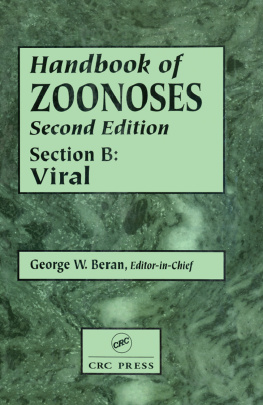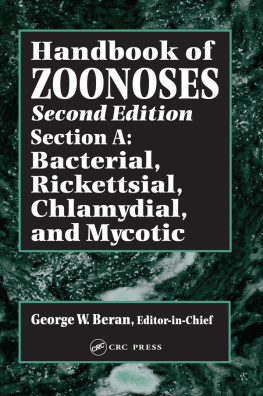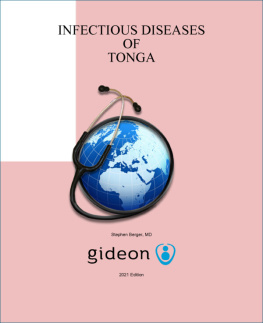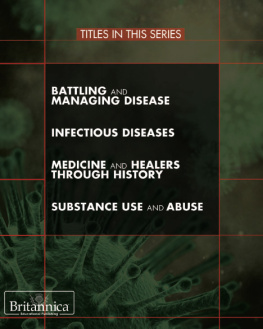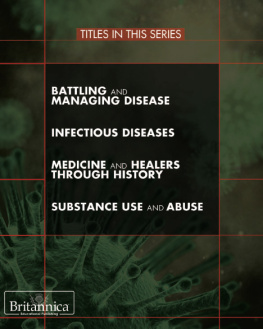Contents
Page List

Handbook of ZOONOSES
Second Edition
Section B:
Viral
George W. Beran, Editor-in-chief
James H. Steele, Consulting Editor
Abram S. Benenson, Editor for Human Diseases
Theodore F. Tsai, Editor for Arboviral Zoonoses
Frank Fenner, Editor for DNA Viral Zoonoses
Michael Torten, Editor for Spirochetal Zoonoses
and Retroviral Diseases

Library of Congress Cataloging-in-Publication Data
Handbook of zoonoses / George W. Beran, editor-in-chief2nd ed.
p. cm.
Revised edition of: CRC handbook series in zoonoses.
Includes bibliographical references and index.
Contents: section A. Bacterial, rickettsial, chlamydial, and mycotic (v. A).section B. Viral
ISBN 0-8493-3205-2 (sect. A).ISBN 0-8493-3206-0 (sect. B)
1. ZoonosesHandbooks, manuals, etc.I. Beran, George W.
RC113.5.C72 1994
616.959dc20
93-48876
CIP
This book contains information obtained from authentic and highly regarded sources. Reprinted material is quoted with permission, and sources are indicated. A wide variety of references are listed. Reasonable efforts have been made to publish reliable data and information, but the authors and the publisher cannot assume responsibility for the validity of all materials or for the consequences of their use.
Neither this book nor any part may be reproduced or transmitted in any form or by any means, electronic or mechanical, including photocopying, microfilming, and recording, or by any information storage or retrieval system, without prior permission in writing from the publisher.
All rights reserved. Authorization to photocopy items for internal or personal use, or the personal or internal use of specific clients, may be granted by CRC Press LLC, provided that $ .50 per page photocopied is paid directly to Copyright Clearance Center, 222 Rosewood Drive, Danvers, MA 01923 USA The fee code for users of the Transactional Reporting Service is ISBN 0-8493-3206-0/94/$0.00+$.50. The fee is subject to change without notice. For organizations that have been granted a photocopy license by the CCC, a separate system of payment has been arranged.
The consent of CRC Press LLC does not extend to copying for general distribution, for promotion, for creating new works, or for resale. Specific permission must be obtained in writing from CRC Press LLC for such copying.
Direct all inquiries to CRC Press LLC, 2000 N.W. Corporate Blvd., Boca Raton, Florida 33431.
Trademark Notice: Product or corporate names may be trademarks or registered trademarks, and are used only for identification and explanation, without intent to infringe.
Visit the CRC Press Web site at www.crcpress.com
1994 by CRC Press LLC
No claim to original U.S. Government works
International Standard Book Number 0-8493-3206-0
Library of Congress Card Number 93-48876
Printed in the United States of America5 6 7 8 9 0
Printed on acid-free paper
PREFACE
HANDBOOK OF ZOONOSES, SECOND EDITION
Human beings, animals, birds, insects and arachnids, and the inanimate environment are all involved in cycles of infection and intoxication of the zoonoses. The term derived from Greek zoon (animals) and noses (diseases) literally means diseases from animals. In this handbook series, infections and diseases are considered that are naturally transmitted between animals or birds and human beings. Transmission may be direct or through arthropod vectors or environmental foci. In some, the etiologic agents exist freely in the environment from which animal or human exposures occur. Foods of animal origin may be the source of infectious agents or toxicants to people.
The number of infections and diseases which can be classified as zoonoses varies from approximately 100 (99 of the 169 infections and parasitic diseases included in Control of Communicable Diseases in Man, 15th ed., 1991) to approximately 3, 000 (separately listing over 520 arboviral infections, over 2, 000 salmonella serotypes, and over 200 leptospiral serovars). The importance of the zoonoses is based on their prevalence as chronic infections and incidence of new infections, the fluctuations which occur in the incidence of infections, the presence of high-risk individuals within populations, the difficulties or costs encountered in attempting control, and the emergence or new recognition of infections of unassessed potential. In this handbook series, 18 bacterial, 10 foodbome, 7 chlamydial and rickettsial, and 3 mycotic diseases are considered important for specific considerations in Section A, and 42 viral diseases for consideration in Section B.
Following an introduction for each zoonosis, consideration is made of its history, etiology, epidemiology, the disease in animals, the disease in human beings, its public health aspects, and references for further study. For many of the zoonoses, reference is also made to the first edition of the Handbook Series in Zoonoses, CRC Press, Boca Raton, FL, published in eight volumes, 19791983.
THE EDITORS
George W. Beran, D.V.M., Ph.D., L.H.D., Editor-in-Chief, is Distinguished Professor of Veterinary Medicine at Iowa State University. He holds a D.V.M. degree from Iowa State University, a Ph.D. in Medical Microbiology with emphasis on epidemiology from the University of Kansas College of Medicine, and an honorary L.H.D. from Silliman University, Dumaguete City, Philippines. He is a diplomate of the American College of Veterinary Preventive Medicine with specialization in epidemiology, and a diplomate of the American College of Epidemiology.
During his career he has served in private veterinary practice; as an epidemic intelligence officer in the U.S. Public Health Service; as professor and director of the Public Health Laboratory at Silliman University; as director of the Central Laboratory of the Province of Negros Oriental, Philippines; and as professor and chair of the Preventive Medicine Program and of the Food Safety Research Program at Iowa State University. Frequently invited to serve the World Health Organization (WHO), he has participated in 3 Expert Committee meetings, 8 Expert Consultations, and 14 international assignments. He is currently a member of the WHO Expert Panel on Zoonoses and Director of the WHO-Iowa State University Collaborating Center for Risk Assessment and Hazard Intervention in Foods of Animal Origin. In 1993 he received the Karl F. Meyer Gold-Headed Cane Award for excellence in epidemiology from the American Veterinary Epidemiology Society.
Dr. Beran is author or co-author of 176 scientific publications, 17 chapters in scientific books, and 2 monographs. During the period 19871993, he made 321 presentations at 512 scientific meetings, 44 of which were international meetings.
James H. Steele, D.V.M., M.P.H., Consulting Editor, received his D.V.M. degree from Michigan State University in 1941, then went on to earn a M.P.H. degree from Harvard University. Dr. Steele was commissioned in the Public Health Service in 1941. He established the Veterinary Public Health Division of the Centers for Disease Control and served as its Chief Veterinary Officer from 19511971. He was Assistant Surgeon General for Veterinary Affairs, U.S. Public Health Service, 19651971. Dr. Steele joined the faculty of The University of Texas (UT) School of Public Health in 1971. During his stint there he founded and edited the

